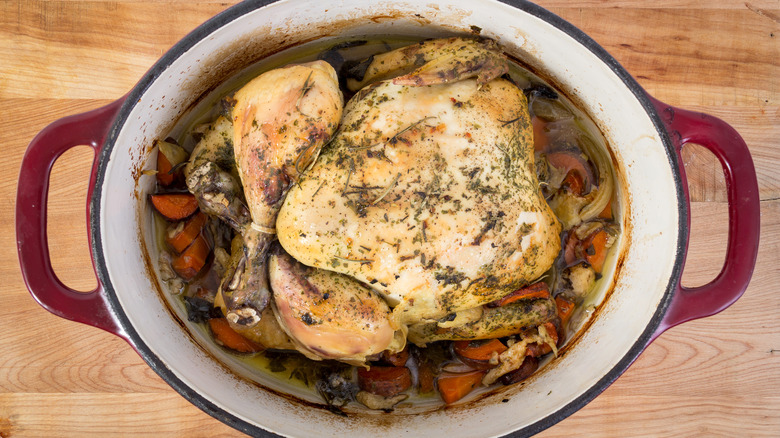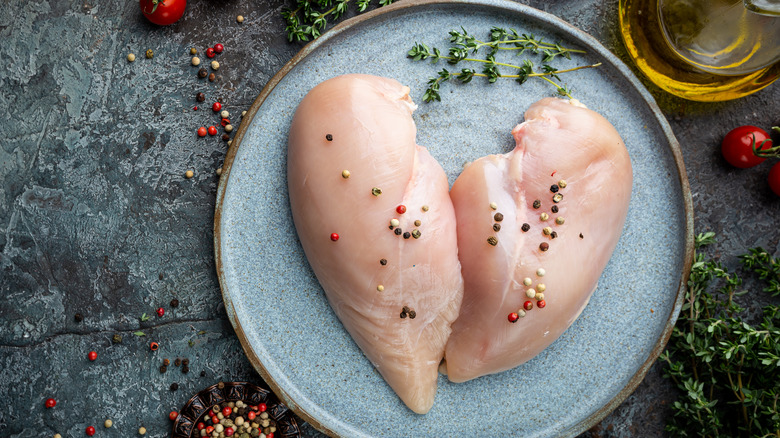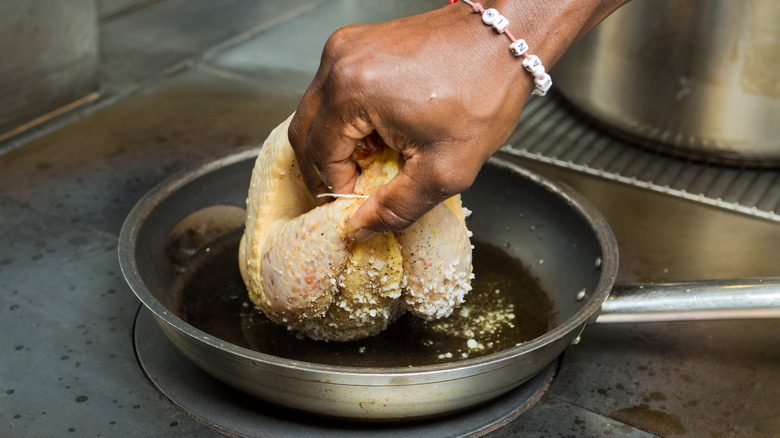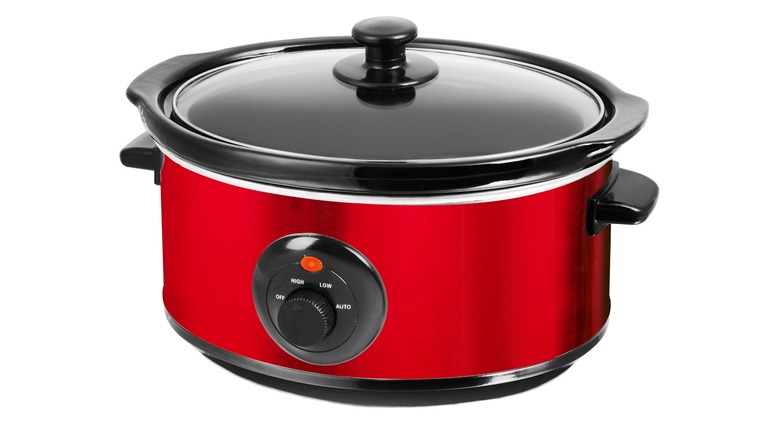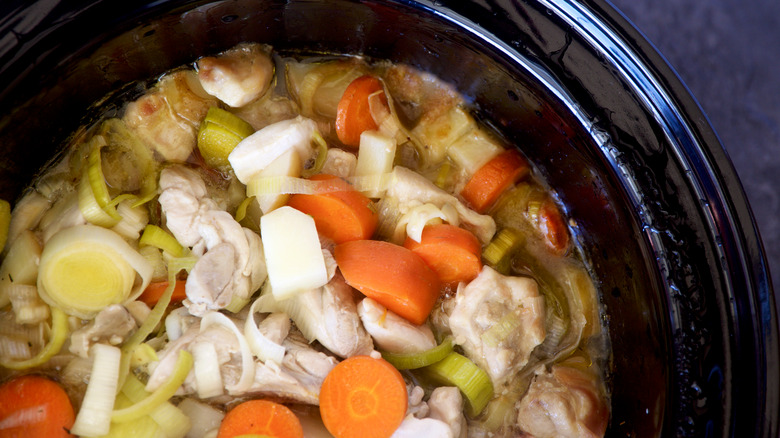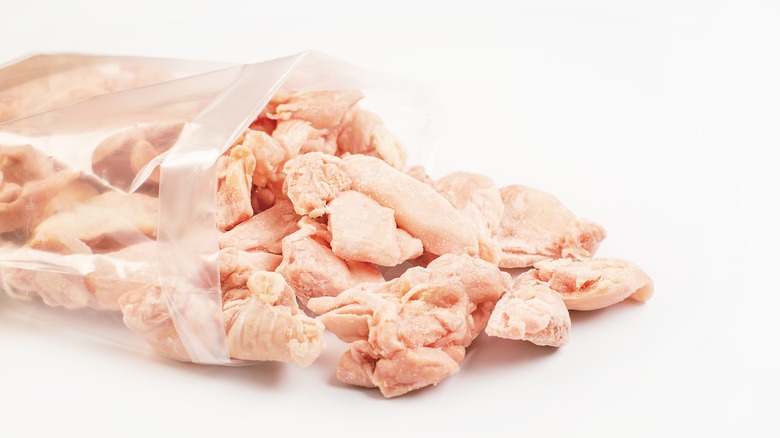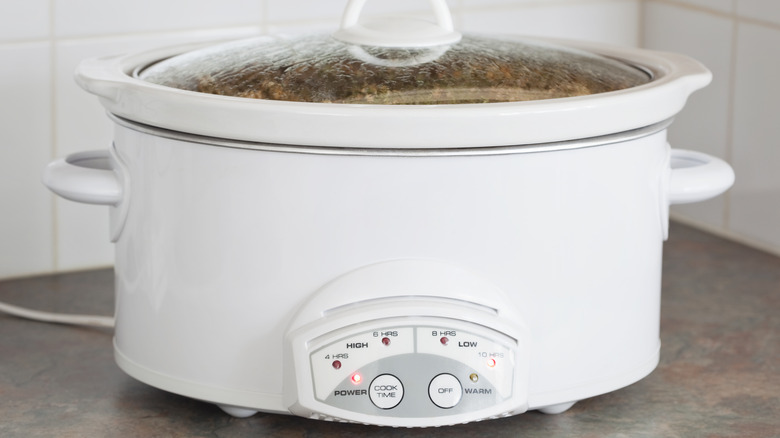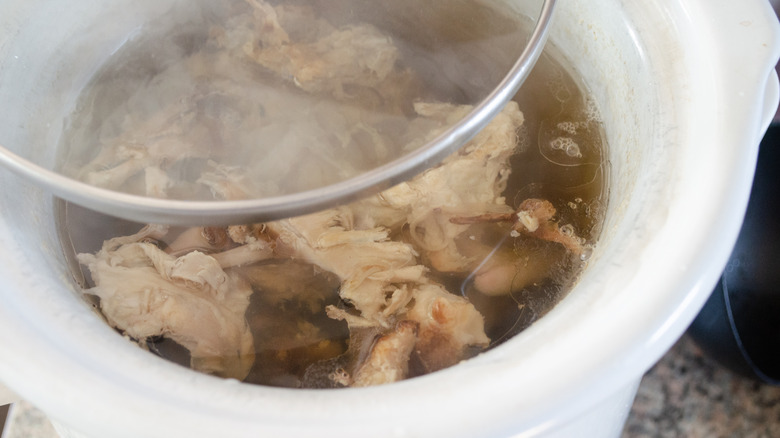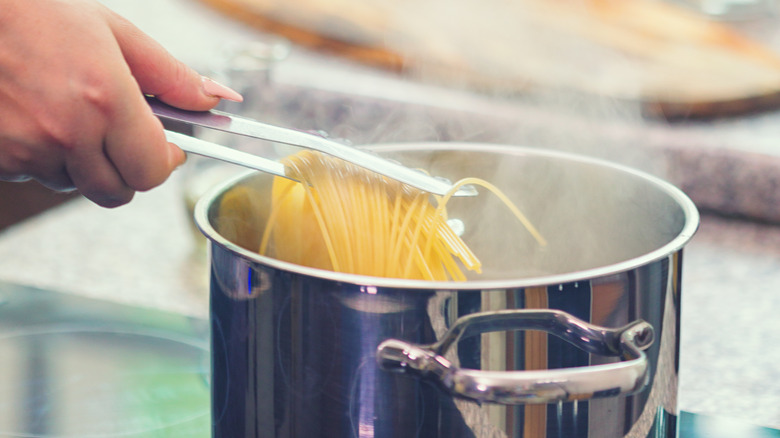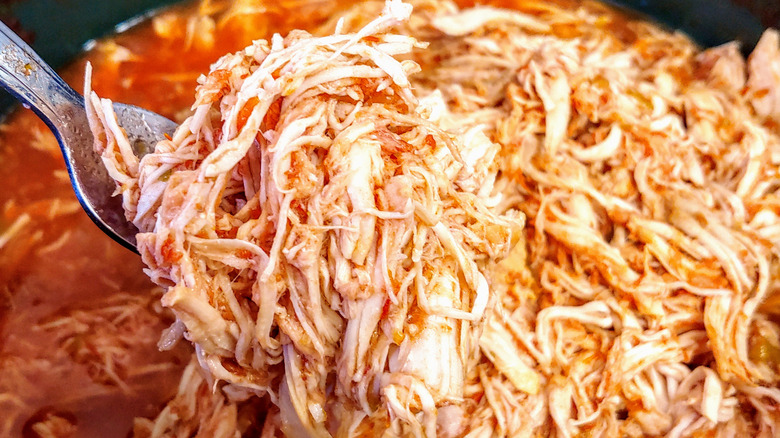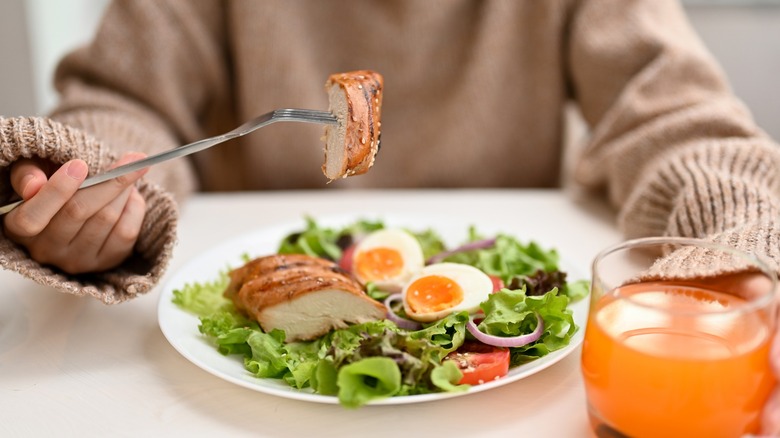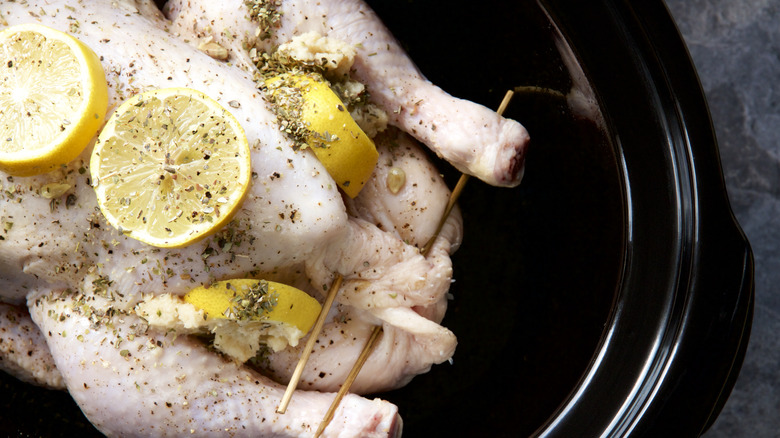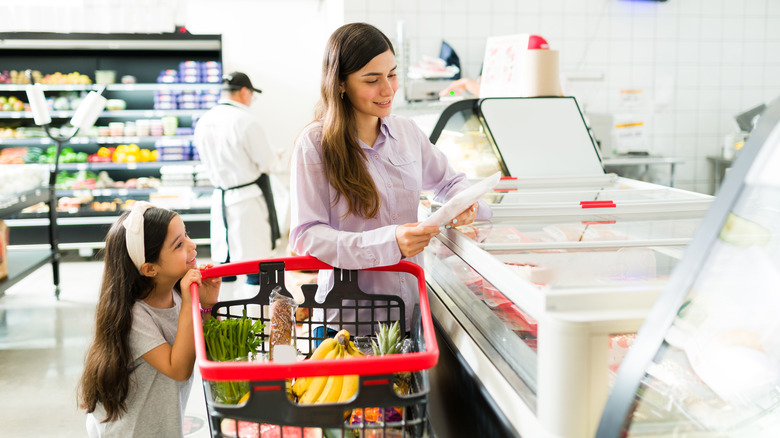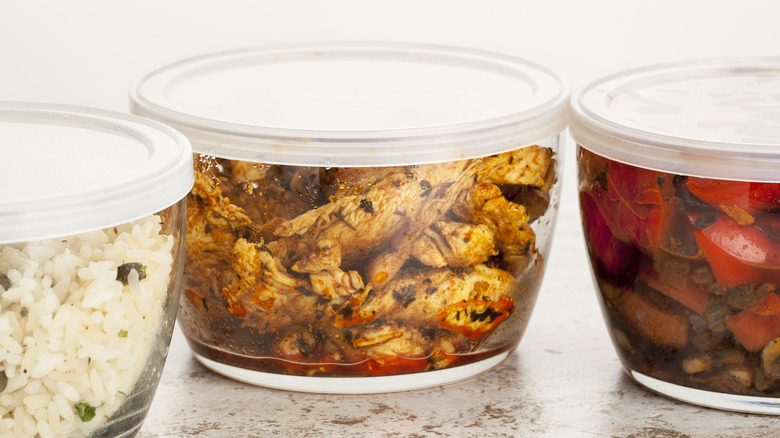The 13 Things You Need To Know About Slow Cooker Chicken
Whether you just bought your very first slow cooker or you're about to dust off the old one, there are some things you should be aware of if you plan to cook chicken with it. When you use this appliance, some different rules apply, compared to when you make the poultry in other ways, like the grill or the oven. To achieve the best final product, selecting the appropriate chicken cut is crucial. Furthermore, the capacity of your machine matters, as well as the steps you take during preparation.
Then, of course, there are unsafe cooking and reheating practices to avoid for the sake of your health. Fortunately, this comprehensive guide is here to equip you with all the information you need regarding slow cooker chicken, including all of its benefits. Before you know it, you'll be a seasoned pro on the subject, which is nice when you want to make the most delicious chicken possible.
1. You shouldn't use chicken breasts
Believe it or not, chicken breasts are one of the worst cuts of meat to put in your slow cooker. This tidbit might come as a surprise since endless recipes are floating around that suggest the use of chicken breasts in your machine. However, you should avoid this, not for safety, but for quality purposes. Chicken breasts are very lean, which is beneficial in certain circumstances, but not when you need to cook them over a long period. Unfortunately, their low-fat content contributes to them shriveling up and having an unpleasant texture.
Slow cooker appliances produce the best results when you use other cuts of meat — think pork shoulder or stew meat. In terms of chicken, the thighs and drumsticks are excellent options since they're much fattier. Another option is to cook the whole chicken and carve it afterward. Then, you can enjoy the chicken breast, which won't be overly dry or tough.
Ultimately, if all you have available is chicken breasts, keep the pieces whole and use plenty of stock or sauce to prevent them from getting too dry. Remove them from the slow cooker immediately after they reach 165 degrees Fahrenheit.
2. Browning the meat isn't mandatory
Although most recipes suggest you sear the chicken beforehand, it's not required. As long as you slow-cook the chicken to the necessary internal temperature, it is safe to consume. If you just want to get all of the ingredients in the pot and get it going, there's no harm in tossing the raw chicken. This is especially true when you make soup or another dish where the chicken isn't the primary component, and it visually blends with other ingredients. However, there are a couple of reasons why people prefer to brown the meat before they slow-cook it.
First, the chicken has a much better presentation when it has some browning on the outside compared to when it is pale. Moreover, when you brown it, you trigger a chemical process called the Maillard reaction. This process imparts the chicken with savory, complex notes that wouldn't otherwise be there. Then, when the chicken goes in the machine with veggies, herbs, and liquids, it gives the whole meal a deeper flavor. The umami essence and golden-brown color are why many people believe you should pre-sear your slow-cooker chicken.
3. The size of your appliance affects the meat's texture
You might think that your slow cooker appliance is a one-size-fits-all and that you can use it for small recipes as well as when you serve a large group of people. Yet, that's not necessarily the case.
It's a good idea to consider how exactly you plan to use a slow cooker before you purchase one. For instance, you might run into trouble if you have a large appliance but only need to cook meals for your family of three. The gadget's capacity can affect your chicken's texture because overly large cooking vessels tend to overcook the meat, making it rubbery.
You can compare this to other circumstances, such as when you heat something in a pan. The more surface area you have, the faster the food cooks, which creates a higher chance of scalding. The opposite can happen too; if you use a slow cooker that's too small — and pack it with a ton of chicken and broth — the meat cooks unevenly, and some parts are ready while others are undercooked. The next time you make chicken in a slow cooker, try to find a recipe designed for the exact size of your machine so that your meat turns out tender and juicy.
4. Slow-cooking the chicken preserves nutrients
When you use your slow cooker, you retain more vital nutrients in chicken, which is always a plus. Many cooking techniques use high heat, which some nutrients can't withstand. On the other hand, Crock-Pots and similar appliances will be around 280 degrees Fahrenheit when they're on high and only 170 degrees Fahrenheit on low.
Yes, some nutrients still escape from the meat, but since slow cookers are sealed cooking chambers, they make their way to the other ingredients in the pot. For instance, the broth or starches take them on, so you still consume the nutrients.
If you grill, fry, or roast the chicken, saving those lost, valuable substances is harder. There's another side to the issue, too. Compounds called advanced glycation end products (AGEs) form with high-heat cooking, and those compounds can harm the body. Healthline states that when AGEs build up in your system, there's a higher chance you develop health conditions such as heart disease or diabetes. But when you use a slow cooker for your chicken, it reduces the formation of AGEs significantly.
5. Cooking the meat from frozen isn't safe
Do yourself a favor and never load your slow cooker with frozen chicken again. Since cooking the meat in the oven from frozen is a common technique, you might wonder how the slow cooker differs. In simple terms, it is dangerous to put unthawed meat in the appliance because slow cookers take so long to bring the chicken out of the temperature danger zone.
The range you need to avoid is 40 degrees Fahrenheit to 140 degrees Fahrenheit because when the poultry is amid these temperatures for too long, bacteria grow to unsafe amounts. Once the poultry reaches the correct temperature, it doesn't kill off the harmful bacteria, as some might believe. Thus, it can give you or your guests food poisoning, according to the United States Department of Agriculture.
Fortunately, this is easily avoidable. If you have time, you can always thaw the chicken in the refrigerator the night before you use it. Or, use the cold water method. Place the chicken in a sealed bag in a bowl of cold water, which defrosts the meat safely. After a half-hour passes, replace the water with fresh water and flip the bag over if needed. Once you notice it's no longer frozen, directly transfer it to the cooking appliance. Ultimately, if you don't have time to defrost it, you might have to settle for cooking the poultry another way.
6. It's not the best meat for set it and forget it recipes
A significant reason slow cookers are so convenient is that you can have the appliance cooking while you're away from home doing things like working or running errands. In fact, the Crock-Pot was invented for the exact reason of work and home life balance for newly working mothers in the early 1970s. However, when you make chicken, it cooks at a much faster rate than other meats do, so you must be careful when choosing which day and time to make it.
Additionally, some models have a built-in warmer mode, which keeps your meal hot for an extended time after it finishes cooking. Avoid this at all costs because the chicken continues to cook, and it'll be dry or stringy by the time you get home. For best results, find a recipe designed for the exact cut of meat you plan to use, and make sure you can be home the entire time or at least before the suggested cooking time is over.
7. Overcooking creates a potential choking hazard
If you cook bone-in chicken, removing the bones before you consume the meat is a good idea. Slow cooker chicken isn't the same as when you make fried chicken wings and can eat the meat straight off the bone. The drawn-out cooking process slowly degrades the bones, which makes them softer. Especially for children or the elderly population, this is extremely dangerous because little pieces can hide in plain sight.
Although you can remove the bones after you entirely cook the meat, there's still a chance of splintered bits. The safest route is to partially cook the poultry, then temporarily remove it from the heat and pull out the bones while they're still hard. Then, transfer the chicken back to the slow cooker until it reaches the correct temperature. Wear gloves if possible and wash any surfaces that come in contact with the chicken since it's not fully cooked yet.
8. You can use the excess chicken juice to boil pasta
Since absorption doesn't really happen in this type of appliance, it often leaves you with natural juices from the chicken, especially when you cook the meat in broth or water. As mentioned earlier, the liquid contains beneficial nutrients. Plus, there's no need to throw out the juice because it has a rich, savory flavor. If you don't need it for your dish, a clever way to utilize the juice is to save it and use it for pasta water.
It's important to remember that this isn't an after-the-fact practice; don't go scooping out the liquid that's been sitting in your slow cooker for a couple of hours at room temperature. Plan ahead and ensure it doesn't cool for too long before you pack it into a container and put it in the refrigerator so it doesn't spoil. Use it within a few days; pasta casseroles and one-pot dishes are ideal since you don't need to strain them, and the delicious meaty flavor soaks into the other ingredients.
9. Every minute counts when shredding slow cooker chicken
Since the slow cooker creates tender chicken, it's suitable for when you make a recipe that involves shredded chicken, such as slow cooker BBQ pulled chicken. Yet, there's a specific way to shred the meat if you want it to come out right. Temperature significantly affects how easily the poultry breaks down into pieces. Allowing the chicken to cool down too much makes it challenging because the meat firms and yields larger, uneven chunks when you try to pull it apart.
So, even though it is easier to touch with your hands once it's cool, you don't achieve the optimal results this way. Instead, you can work with it while it's still pretty warm and use tools like forks or tongs to save your fingers from getting burned. The utensils do a fairly good job of creating even strands perfect for things like enchiladas or tacos where you don't want chunky pieces to take up all the space. Furthermore, a stand mixer with a paddle attachment works efficiently, but this will create more dishes to wash.
10. Pink chicken isn't always inedible
Staying away from pink chicken is undoubtedly smart — especially when you can't confirm that the meat reached 165 degrees Fahrenheit, such as if you didn't cook the chicken. After all, you've probably heard all your life that chicken needs to be white for it to be done. But on the flip side, you might be surprised to learn that not all pink chicken is harmful. Sometimes, poultry has natural pinkish undertones even when you take all the proper steps to prepare and heat it, as reported by the USDA.
There are many factors that can lead to the poultry having an off-white color, such as the bird's age, hidden fat layers, and nitrates. This can even happen when you cook ground chicken in your slow cooker, too. So, before you decide to keep your meat in the machine for longer just because of its color, determine if it actually needs more time. If you find it's definitely past the required mark, there's no need to worry about it. That is, as long as it has pale tones.
11. You don't need to add liquid in some instances
Surprisingly, some chicken recipes turn out better when you don't add liquid to the chamber. Using liquid is the typical practice, and it's much needed when making most dishes. But sometimes, the meat has enough natural moisture to do the job, so adding extra is overkill. Remember that slow cooking is different because any liquid you add in the beginning is still present at the end of the cooking time, plus additional moisture from the chicken.
A perfect example of when you don't need to add broth or sauce is when you make a whole chicken and vegetables in the Crock-Pot. All you need is a little olive oil on the bottom of the pot, then drizzled on the vegetables and rubbed on the meat. You can stack the whole chicken on top of a layer of mixed vegetables, and the chicken juice mixes with the oil to prevent any dryness in the meal.
12. It saves you money
Slow cooker chicken saves you money in more than one way. First of all, this machine allows you to buy the most cost-effective chicken for dinner, such as whole chicken legs, drumsticks, or the entire chicken. These parts of the bird have a tough consistency when you cook them other ways, which is why people usually lean towards different options that are easier to deal with. However, when you heat them low and slow, it makes them juicy and tender.
Secondly, you lower your electric bill using a slow cooker instead of an oven. Crock-Pots and similar models only use up as much energy as an everyday light bulb, so they are much more energy efficient than the average oven. CNET ran a small test to compare energy costs in different appliances, and the results were astounding. The example recipe was pork instead of chicken, but the same applies. The price per hour of cooking in the oven was 51 cents, compared to only 5 cents in the slow cooker, and when you need to cook the meat over an extended amount of time, every penny counts.
13. You can't reheat it the same way you cook it
A general rule of thumb is to reheat your food the same way you initially cooked it. For example, heating leftover stir-fry on the stovetop produces much better results compared to if you use the microwave. However, it's not smart to do that with slow cooker food, especially poultry. Although you might enjoy the taste and texture of the chicken the first time you cook it in the appliance, you shouldn't try to replicate that with the leftovers due to the temperature danger zone.
Plus, who wants to wait all day, or at least a few hours, for their food to reheat? It just makes more sense to use a quicker method. If you want your leftover chicken to taste as good as the first time, you can bake it in the oven with some stock or sauce. Cover the chicken for the first part of cooking to prevent the oven from sucking out all the meat's moisture. You can also do this on the stovetop if you add liquid, turn the heat to medium, and cover it with a lid.
